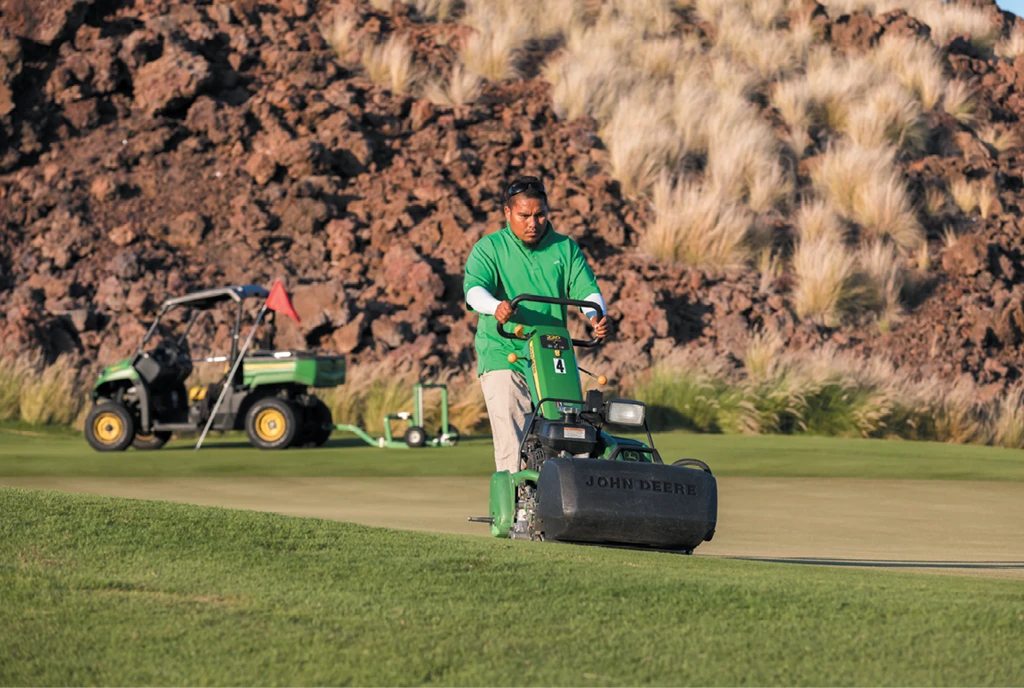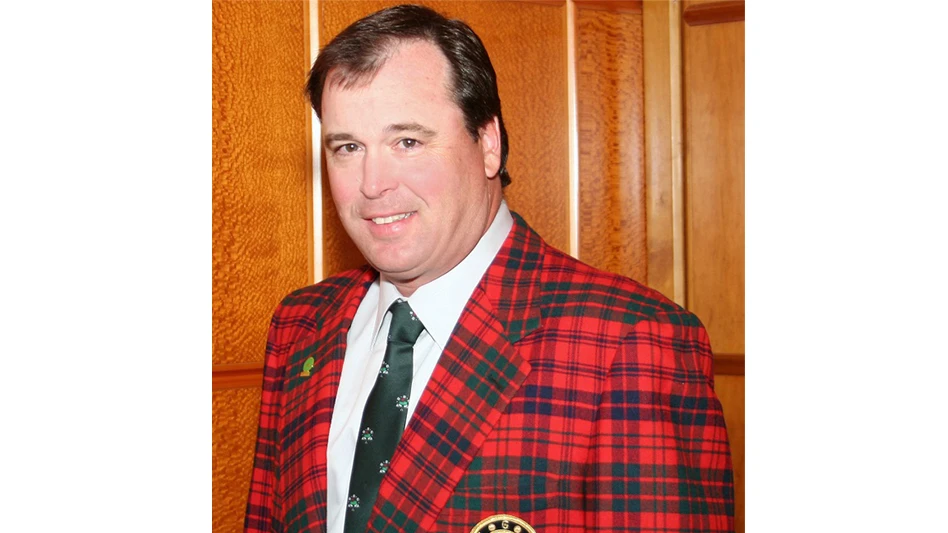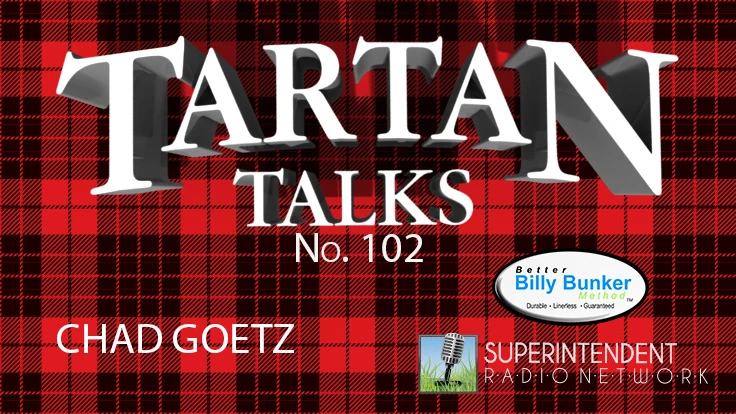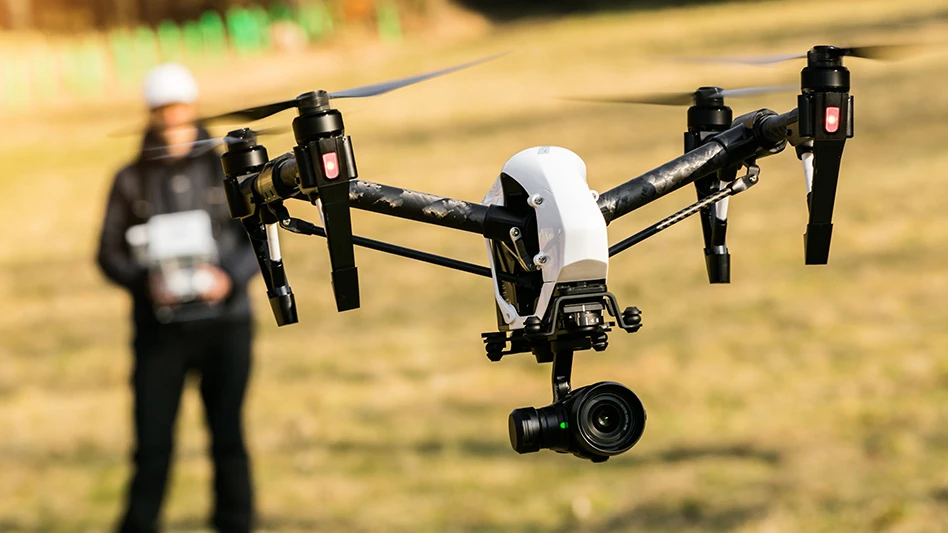


Something was missing from Jake Lerback’s soul. Nobody played golf at Kona Country Club for a three-year stretch.
A public facility offering reasonable rates for residents of Hawaii’s “Big Island,” Kona CC underwent a massive transformation from 2013-16, as ownership shuttered the Mountain Course and enhanced the Ocean Course. Lerback remained employed as a night irrigator through the transition.
Lerback left the car stereo installation business in 1997 to begin working the 4:30 p.m. to 1 a.m. irrigation shift. He manually operated the system on the Mountain Course, keeping Bermudagrass alive and maintaining his family’s place on the Big Island golf scene. Lerback’s father, Vern, a World War II veteran, worked as a marshal on the course. Vern died before Jake realized he could use his electrical talents to repair valve boxes instead of sound systems.
“What has kept me here?” Jake says. “It’s all for my dad. This was his home playing field. He passed away a long time ago. I have always taken care of the course for Pops.”
Jake, now a self-described “everything guy” on the Kona CC crew, describes his path to golf course maintenance as sun soaks the surrounding Keauhou Bay on a mid-March morning. The course also represents the home playing field – and place of employment – for his 21-year-old son Josiah Lerback, who’s changing cups as Jake reaches the 18th green in his cart.

Golf arrived in the Keauhou Bay, a conglomeration of resort and residential development, shops and historic sites overlooking the Pacific Ocean, when Kona CC opened in 1966, two years after the famed Robert Trent Jones Sr.-designed course at Mauna Kea Resort debuted. Mauna Kea, 40 miles north of Kona CC, represents the patriarch of the Big Island’s coastal courses.
Because golf is still a young industry on the Big Island, with the bulk of course development occurring in the last 20 years, generational employees tending to the same course over decades such as the Lerbacks are anomalies. Even without shared last names and Golden Age histories, a sense of family, or as Hawaiians call it ‘ohana, defines the worker experience on Big Island golf courses.
Joey Kaeka and Brian Payapaya are cogs in developing ‘ohana at Kohanaiki, a private facility in the shadows of Kona International Airport. An oceanfront development that started and stalled during the Great Recession, Kohanaiki, the youngest of the Big Island’s 18 golf facilities, needed workers in 2012 to complete the course for its 2013 unveiling. Kaeka and Payapaya needed jobs.
Kaeka, a tugboat industry veteran from Oahu, the most populated of Hawaii’s eight islands, moved to the Big Island in 2012. He arrived at Kona International Airport, drove to Kohanaiki’s main gate, inquired about work and had a job on the course the following day. Payapaya, an island resident since the mid-1980s, installed tile and granite, delivered water, and performed residential maintenance. Work slowed during the recession, so he followed his brother-in-law’s suggestion and applied for a construction job at Kohanaiki. Every construction position was filled, but he received a golf course maintenance job. Payapaya started three months after Kaeka, making them two of the longest-tenured employees on the Kohanaiki crew.
Their department, which also maintains common and home landscape areas, ponds, a public and private beach park and community garden, has swelled to 70 employees. A communal spirit exists on the job despite the large team needed to maintain the grounds of an 18-hole amenity-laced club. “‘Ohana is family,” Payapaya says. “That’s what the word means. ‘Ohana is a real big thing for us.” ‘Ohana, surprisingly to outsiders, expands rapidly. “It’s not just a blood thing,” Kaeka adds. “It’s a feeling that we’re so close friends that we are like brothers. I think that’s pretty unique because you are going to have people come and go.”
Kohanaiki agronomy manager Joey Przygodzinski, a Big Island native, introduced a variety of Hawaiian terms and values to a visitor earlier this year. His primer begins with aloha, a welcoming spirit and term familiar to those who live outside Hawaii. He considers ‘ohana the most important native concept when creating a successful work culture.
“It’s the ‘I will take care of you, if you take care of me,’” he says. “And ‘ohana can mean friends, too. ‘Ohana is always growing because you keep making new friends. It’s just the feeling that we will go above and beyond for each other, because that’s how we like to treat our family.”
Four Seasons Resort Hualalai director of golf course maintenance Dan Husek, an Illinois native, moved to the Big Island in 2004. Experience has taught him employees “really look out for each other, not just at work but outside of work.”
Brozie Ambrose and Chance Lincoln are two of the leaders on the team Husek manages. The duo helped build the resort’s first 18-hole course in the mid-1990s and they carry an abundance of stories about hauling lava rock and donkeys destroying young turf. Ambrose and Lincoln, a pair of Big Island natives, demonstrate immense pride as they escort a visitor onto the 17th green, a photogenic hole wedged between lava rock and the Pacific Ocean. The par 3 receives significant attention when Golf Channel broadcasts the PGA Tour Champions Mitsubishi Electric Championship each January. The broadcast, though, never describes the effort it took to transform a punishing landscape into a pleasurable spot.
“A lot of labor,” Ambrose says. “We had a deadline to get the golf course ready to build a hotel. I think we worked some weeks 10 hours, seven days a week. There was overtime. You could just make whatever you wanted. Labor was hard. We didn’t have any carts with roofs at that time. We were always in the hot sun. We had to bring our own lunch. We had to bring our own water. Nothing was provided. You just had to survive. If you wanted to survive in the sun 10 hours a day, you had to make sure you brought enough food to eat and water. Some people didn’t last two hours.”
Ambrose and Lincoln have lasted more than 20 years. Enduring construction and learning the intricacies of golf course maintenance not only enhances their lives. The work also has expanded their network. Lincoln says the ‘ohana created through a demanding job provides “a sense of security.” Ambrose commutes more than 90 minutes each way, because of the relationships he has established with co-workers, the land and his supervisors.
Once natives sense ‘ohana, thoughts of leaving for a more lucrative job often wane. “I think the majority of my staff – if you ask them why they like to work here – they are going to say because of the guys I work with,” Husek says. “It’s not going to be because I get X amount of dollars or I get a free lunch. It’s not going to be the cafeteria. It’s going to be I like the guys that I work with. That’s always satisfying when you hear that.”

Stories of courses on other islands, including neighboring Maui, offering higher wages to attract experienced foremen or greenskeepers reaches employees on the Big Island, through what Hawaiians call the “coconut wireless.” But a family-driven work environment creates loyalty. “It’s like, ‘They pay this much!’” Payapaya says while stretching both hands past his shoulders. “Maui is one thing. It’s good. But if I go there, am I going to be as happy as I am now? I was pretty much raised with Kohaniki. I have seen it grow. It’s hard to leave a place.”
Mauna Kea director of golf Josh Silliman says the resort boasts multiple employees “who have had one job their entire life.” The staff includes an irrigation technician hired by legendary developer Laurance S. Rockefeller approaching his 55th anniversary at the resort.
Outside of work, natives often live in the same neighborhoods where they spent their childhood. Jake Lerback lives in a hillside community lined with small farms. Some people in the neighborhood farm; others hunt and fish. “There’s always something there,” Lerback says. “We will call people up and go, ‘Hey, do you have some fish? Or do you have some pig?’ And then when you have something, you call people up and tell them.”
‘Ohana helps newcomers handle the isolation and expenses associated with life on the Big Island. Kaeka realized the island contrasted Oahu, which he describes as a “hustle,” when five people offered to help him fix a flat tire he received shortly after moving. Whenever one of his children get sick and neither Kaeka nor his wife can miss work, somebody he trusts will volunteer to help. “You know how they say, ‘It takes a village to raise a kid?’” he says. “That’s how it is here.”
Nanea Golf Club director of golf course maintenance Scott Main, an Ohio native who has worked in multiple states, moved to the Big Island in 2014. Three weeks after moving to the island, Main and his wife told a fellow parent at a youth soccer about their daughter’s interest in trying the ukulele. The Mains were undecided on whether to invest in a new, and unfamiliar, musical instrument. When they arrived at the field the following week, the same parent handed them a ukulele, urging their daughter to try it without reservations. “The culture is very giving,” Main says. “People want to hear stories. They want to hear your story and they want to tell their story.”
Sharing stories makes the workday more interesting. And knowing more about the person mowing the adjacent green or fairway contributes to the island’s splendid golf landscapes. “Having that family feeling makes the job more enjoyable,” Kaeka says.
Latest from Golf Course Industry
- Melrose leadership programs sending 17 to GCSAA Conference and Trade Show
- Maximizing your experience at trade shows: tips and etiquette for attendees
- Tubac’s Rancho 9 re-opens after greens renovation
- Future Leaders Academy set for Jan. 23 in suburban Pittsburgh
- 54, Turfgrass set to manage Druids Glen, Curracloe Links
- Nufarm introducing new products in San Diego
- Envu Superintendent Grant Program sending 10 members to 2025 GCSAA show
- Editor’s notebook: Let’s chat about AI





